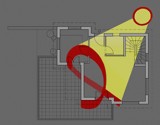Supervisor:
Architectural Technology
2009
In the past, Earth’s climate has changed many times as a result of natural causes. However, the changes in the past few years and the ones forecasted in the future, are mainly the effect of human behavior. Billions of tones of CO2 are emitted annually and as a result the greenhouse effect gets worse; emissions that are created by the consumption of energy resources. The contribution of the Greek households in the balance of the energy consumption is significant, since their energy needs correspond to 32% of the total.
For that reason, the orientation to a more energy-efficient residence seems to be the only solution. Residences that could preserve energy while respecting the environment, seems to be the answer to the problem. Important measures and solutions are at the stage of implementation on a national level; the most important of which is the voting and implementation of the Greek regulation for the energy efficiency of buildings: “Law 3631 – Measures for the reduction of buildings’ energy consumption”. This regulation sets limits for the energy consumption of each type of building which are applied through the process of building inspections. This measure is forecasted to significantly reduce the buildings’ CO2 emissions by the end of 2016.
As a starting point, the environmental problem and the search for its resolution through energy design of buildings, has been the cause for the conception of many non-governmental certification labels. These labels aim in the improvement of the building sector’s energy behaviour and they are used in order to certify, those specific buildings that adhere to the solutions and limitations that the certifications define. One of the most important certification labels is the “Passive House” label, which was introduced in Germany in the 1990 and progressively it was adopted by the whole Central Europe and currently it is being applied in southern hot climates.
The “Passive House” buildings have a series of strictly defined conditions which mainly concern the way of the building’s construction and the methods of heating, cooling and ventilation. Particular emphasis is given to the heat insulation, airtightness and the ventilation of the building with mechanical systems and by limiting the heating’s consumption rate (≤ 15 kWh/m²/year) as well as the size of the primary energy (≤ 120 kWh/m²/year), creating buildings of excellent energy efficiency.
Having as a prime target the conservation of energy for an existing residence in Volos, a study is being made of the residence’s energy requirements using simulation. Next, an improved energy efficient model is being created by studying the Passive House model. By suggesting, increased insulation levels for the structural elements of the building, high air insulation, high technology windows, shading systems for the windows and cooling through night ventilation, there is significant reduction of the residence’s energy requirements in comparison to the current situation.
